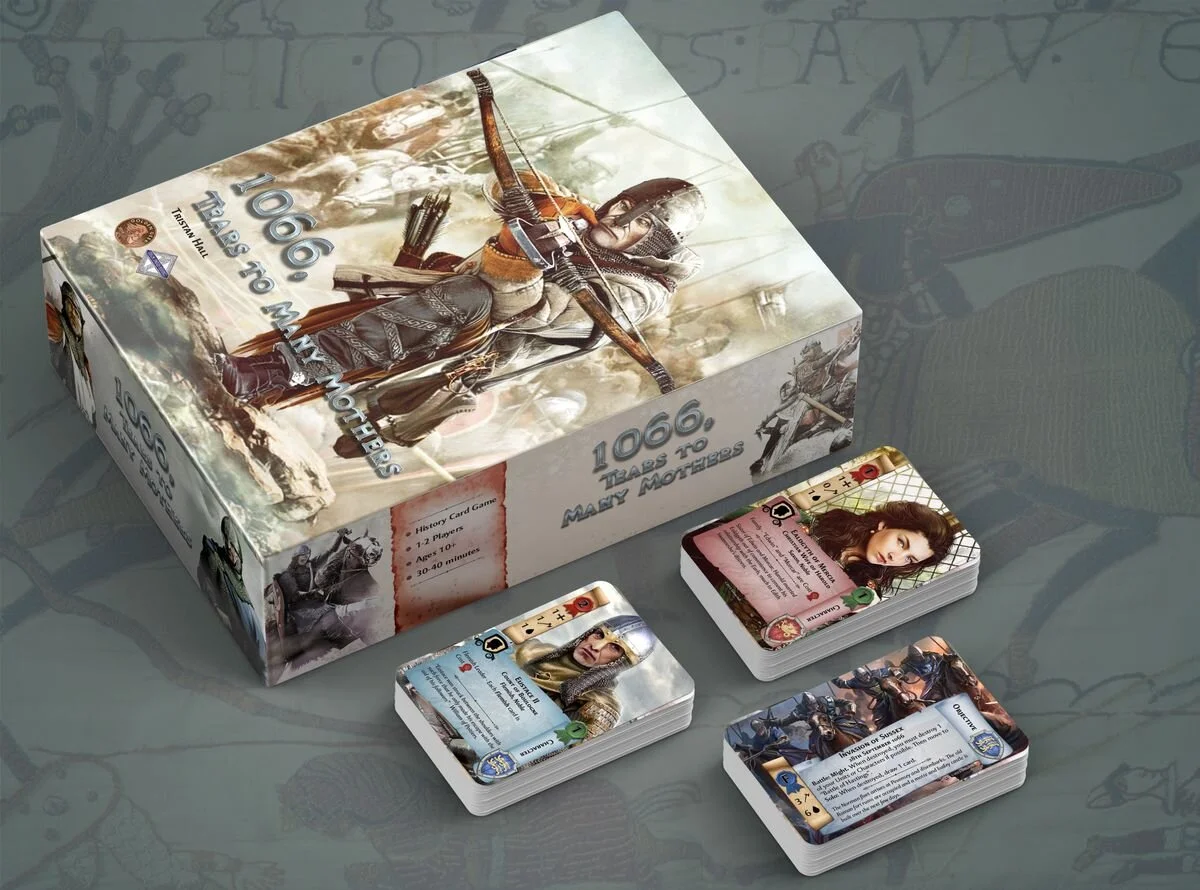1066, Tears to Many Mothers – First Impressions
Review copy provided by the publisher
Technically, 1066 is not the game on most people’s radar. Tristan Hall, the designer behind the historical card game, is currently campaigning 1815, Scum of the Earth on Kickstarter. That’s the third game in the series and it’s already over 300% funded.
But I’ve just recently become aware of the Historical Epic Battle System (HEBS) and so it makes sense to go back to the start and see what Tristan conceived with 1066, Tears to Many Mothers. The game’s physical release in 2018 seems like a long time ago, but the HEBS system is very much alive.
The two-player, asymmetric card game features the Normans and Saxons in the famous Battle of Hastings and it possesses some really awesome art to boot. Because players can use the faction decks from each of the HEBS series’ games interchangeably, 1066 is still a pertinent game to the current state of the series.
While I’m definitely interested to see how 1565 and 1815 play now that Tristan Hall has additional years of design experience and community feedback, it’s exciting to explore what 1066 has to offer.
Here we go!
What It Does
"You've come, have you? – You've come, you source of tears to many mothers. It is long since I saw you; but as I see you now you are much more terrible, for I see you brandishing the downfall of my country."
While that famous quote (from the monk Eilmer of Malmesbury Abbey) refers to Halley’s Comet, it can just as accurately portray what players will feel as their combatant sits across the table in a game of 1066.
The asymmetric tactical game creates a lane-system, similar to other titles like Air, Land, & Sea or Crimson Company, in which players must compete for strength by playing cards from their hands, activating abilities, and trying to create an engine of resources and unit abilities that overwhelms whatever forces the opposition musters.
It’s a tactical card game, but it’s not a collectible game that requires active pruning and growth—once you buy the game you have all of the content. Additionally, you have future content that you can mix with other games from the HEBS series to create more asymmetric combat experiences.
In this game, though, the conflict in question is the Battle of Hastings and the two players will operate as the Normans and the Saxons. Each faction has unique cards, so it will be numerous games before players familiarize themselves with the full potential of each deck.
Each player, as either Normans or Saxons, musters troops and resources to overcome the various obstacles in their way before the two armies clash on the battlefield at Hastings.
All of the cards bear historical significance—either representing a real person or event from that era—and the game quickly engages both players in a taut struggle for supremacy on the battlefield.
How It Does It
This is not a hard game to figure out. It’s not a deck-builder. It’s not a tableau-builder. The engine-building is minimal. Players just have to shuffle their deck and get started.
Three central design elements in the game interact while you play:
A small objective deck keeps players in check in the first two-thirds of the game. Each objective has requirements that must be fulfilled before a player can move onto the next. Objectives are resolved at the end of each turn.
Players deploy units and significant characters to the battlefield, choosing one of the three lanes to position their forces. Events and tactics are played as well, but they resolve outside of the battlefield tableau.
Once all objectives have been completed by one or both players, the central lanes (known as wedges) begin to engage in combat (both indirectly through Zeal and directly through Might).
At the intersection of these three mechanisms is the beauty of 1066, Tears to Many Mothers. Players are not building from the deck for a stronger hand. They must react to what is drawn and determine the best cards and combinations to unleash on their opponent.
One game might involve a player employing multiple ranged units to injure and kill the opponent’s forces. Another game might see the Normans build a strong Zeal engine with their forces to push through objectives quickly. Or the Saxons might develop plentiful resources to field strong units and characters for the endgame wedge fighting.
It really just depends on what you draw. And how you play the cards in your hand.
Why You Might Like It
The artwork is superb for a card game and it really draws you into the historical setting and makes the Norman and Saxon armies come to life.
When you get a close game, it can feel really nervy and engaging as players push back and forth in the wedge fighting with big blows raining down from Zeal and Might contests.
Why You Might Not
Sometimes a game can be lopsided. It depends on the luck of the draw with each player deck. One game involved me using archers to slowly whittle down the enemy leader and the other player was unable to stop the attacks.
The objective decks will remain the same for all games, so there will be less variety in the ways that you want to deploy your units or characters.
Final Thoughts
Tristan Hall has something really interesting here.
I love military history (really just history in general), and it’s exciting to see games that are focused on singular events. The Battle of Hastings is an oft-overlooked conflict (if you haven’t spent any time in the United Kingdom); I enjoyed jumping back into the bloody encounter between the Normans and Saxons.
Also, the illustrations for this game are remarkably good. It’s one of the biggest draws (no pun intended) of 1066 and players eyes’ frequently drift to the artwork before the text. That’s impressive for a card game. Individuals on both sides of the battle have an air of authenticity and gravitas to them. The violence is not cartoonized or made superficial. It’s brutal-looking. I appreciate that layer of realism.
There is also solo play for this game, which is more and more of a positive for me as my schedule continues to… dense-ify. I like the idea of having some historical, tactical card games in the collection. Especially of less visible conflicts from world history.
And then you can use decks from different HEBS games together. That’s a really interesting feature of this series and makes asymmetric gameplay more appealing. It increases the nuance of each deck as you can discover new ways to combine them against different opponents. I like the potential that’s there. I’ll have to see how it pans out, but I’m really intrigued.
There are some smaller quibbles that tripped me up throughout my time with the game, though. It’s possible that they are ironed out in 1565 and the upcoming 1815, but I won’t know until I try them. Some games of 1066 were really swingy. And there wasn’t much that the players could do about them. It was just the random chance of which cards were drawn and how they were able to set up an engine for one player or counter the moves of another player. I’m hoping that there are ways to mitigate that and create a more tense experience every time because the game shines when that equilibrium is achieved. And then the box size is another thing that bugs me. Granted, the game was released in 2018, before many publishers and designers seemed to focus as intently on box design and storage efficiency, but this game could come in a box a third of the size (a ton of wasted space). The rulebook is the only thing that justifies the larger size. I anticipate consolidating all three of the games together into one box.
But I have to keep in mind that this is a relatively inexpensive game. It’s a one-time purchase. It’s not going to demand a collector’s fervor to keep up with a deluge of content releases. It’s a self-contained tactical wargame. And it can be condensed into a small-box experience for players to cart around with them whenever they get the itch to see the Normans and Saxons clash in a frenzied pitch of medieval bloodlust.
If 1066 sounds like something you’d play, Tristan Hall has got some games for you to check out and there is still time to join as a backer for 1815, Scum of the Earth on Kickstarter.
Have you played 1066, Tears to Many Mothers? Do you like any other historical board games?
Let us know in the comments and give a recommendation for other games of which to share our first impressions.




